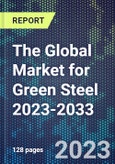Steel is the most commonly used metal globally. There is a high environmental cost associated with traditional steelmaking, with greenhouse gas (GHG) emissions from steelmaking account for an estimated 8-9% of the total global fossil and industrial emissions. The industry is seeking to develop more environmentally friendly production processes and products, driven by net-zero emission targets set by governments and industries. The steel industry is facing a significant challenges regarding carbon emission reduction, resulting in the development of green steel.
Green steel refers to steel produced through more sustainable and low-carbon methods resulting in significantly lower lifetime emissions compared to conventional steelmaking. Key production routes include use of hydrogen direct reduced iron, renewable energy, electrolysis, and carbon capture and storage.
Currently, green steel accounts for less than 1% of global steel production, around 10 million tons annually. However, the market is growing and Thyssenkrupp AG recently received a 2 billion euros package of state subsidies from the German government for its proposed green steel production. By 2033, estimates project green steel could surpass 230 million tons as costs decrease and policy incentives align.
Report contents include:
- Opportunities and challenges for green steel.
- The role of hydrogen in green steel production.
- Analysis of green steel production processes.
- Hydrogen Direct Reduced Iron (DRI)
- Electrolysis
- Carbon Capture and Storage/Use
- Biochar replacing coke
- Hydrogen Blast Furnace
- Renewable energy powered processes
- Flash ironmaking
- Hydrogen Plasma Iron Ore Reduction
- Ferrous Bioprocessing
- Microwave Processing
- Analysis of advanced materials in green steel.
- Composite electrodes
- Solid oxide materials
- Hydrogen storage metals
- Carbon composite steels
- Coatings and membranes
- Sustainable binders
- Iron ore catalysts
- Biosteel metallics
- Carbon capture materials
- Waste gas utilization
- Market analysis including prices, plants, market maps, SWOT analysis, market trends and opportunities, recent industry developments and innovations, market growth drivers, market challenges and end-use industries including automotive, construction, machinery, electronics etc.
- Global market revenues, historical and forecast to 2033, segmented by end-use industry and region.
- 44 company profiles. Company profiles include production processes, planned capacities, collaborations and agreements, future strategies. Companies profiled include ArcelorMittal, Blastr, Boston Metal, GravitHy, H2 Green Steel, Nippon Steel, SSAB and Thyssenkrupp.
This product will be delivered within 1-3 business days.
Table of Contents
1 RESEARCH METHODOLOGY2 LIST OF ACRONYMS
Companies Mentioned (Partial List)
A selection of companies mentioned in this report includes, but is not limited to:
- Agor Steel
- Aperam BioEnergia
- ArcelorMittal
- Blastr Green Steel
- Boston Metal
- China Baowu Steel Group
- GravitHy
- Electra Steel
- Hybrit Development
- H2 Green Steel
- IMP
- JSW Steel
- Magsort
- Nippon Steel
- Nucor
- POSCO
- Primetals
- Reliance Steel
- Salzgitter
- SSAB
- Steelanol
- Sunvik Steels
- Swiss Steel Group
- Tata Steel
- Thyssenkrupp
- TKS
- Triolex
- Voestalpine
- Void Metal
Methodology

LOADING...








